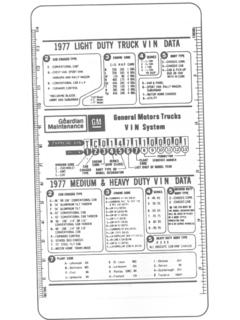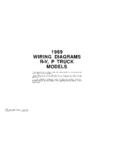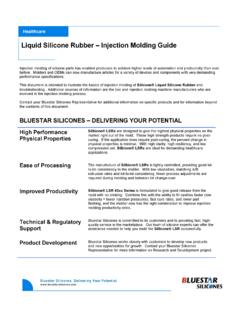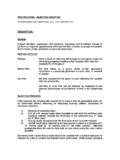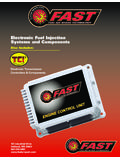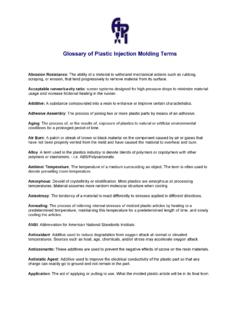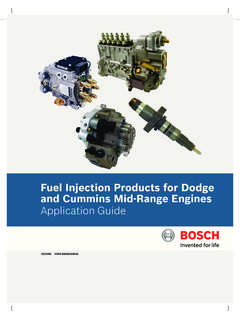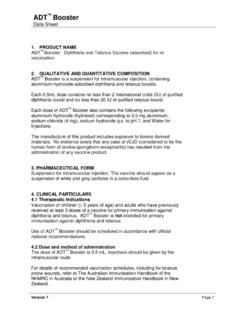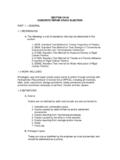Transcription of Troubleshooting your TBI Fuel Injection System
1 Troubleshooting your TBI Fuel Injection System Most of the problems encountered while installing your fuel Injection System or after a time of operation are very simple. If your check engine light is on you more than likely have a hard fault meaning something is grounded out, unplugged, operating out of range or has gone bad. See below for how to determine what your fault may be and what the codes mean. With the addition of Fuel Injection to your engine it is important to remember that the basics are still there, necessary and have not changed. Batteries must be fully charged, charging systems fully operational, the ignition System is fully operational and the integrity of the engine is intact. All of these items are common to an engine and need to be in full operational condition regardless of the fuel System that has been added to your engine.
2 The ALDL connector allows for full diagnostics of your unit. A scan tool can be used and set up for a GM TBI application to read the data, or to check for stored codes. Consult a service manual or see below for any check engine light code definitions. You can use a late 80 s or early 90 s GM TBI definition. If you have access to a scan tool use a hook up for a 1990 350 cu. in. Chevrolet truck. For some scan tools enter VIN 10th L 3rd C 8th K . If you have installed a Fuel Injection System in your vehicle and are having some initial issues here is a quick checklist to work from to get you started. 1. Check to make sure your check engine light is not on, or that it is on with the key on but the engine is not running. Pink Ignition wire MUST be connected to 12 volt switched ignition that receives power during crank and key on. 2. Make sure that the red battery wire is connected to a battery source (It is highly recommended that this wire is connected directly to the battery) and the pink wire is connected to an ignition 1 source.
3 If your ignition wire is not connected to an ignition 1 source your ECM will not be powered while cranking the engine. 3. Check that the ground wire is securely fastened to the block and that the interface between the block and the terminal are clean. 4. Ensure that there are NO vacuum leaks. 5. Ensure that your MAP sensor is connected to a full manifold vacuum source and not a ported source. 6. Set the ignition timing correctly making sure that you disconnect the set timing connector to set it. In some cases you cannot set the timing with the connector disconnected and keep the engine running. If this happens set timing to 15 degrees, allow the engine to fully warm up, then disconnect the set timing connector to set the base timing to the correct specification. 7. Ensure that you have full manifold vacuum routed to your fuel pressure regulator (if equipped on MPFI systems) and there are no vacuum leaks with this connection.
4 8. Check your fuel pressure to ensure that you are providing the proper pressure to the System . Fuel Pressure is critical for proper operation. Fuel tank must be free from debris and fuel pressure needs to be constant and consistent. Some aftermarket high density fuel filters can cause a large drop in fuel pressure under load and are not recommended for use with your System . If you are using one of these types of filters insure that you have proper fuel pressure during all modes of operation. 99% of all issues are usually taken care of with one or more of these 8 steps of diagnosis. First and foremost the engine and fuel Injection System must be free from vacuum leaks. Vacuum leaks are the leading cause of installation issues with your fuel Injection System . Check all sources of potential vacuum leaks including components not related to the fuel Injection System .
5 There are instances where the vacuum leak is coming from the adapter plate used to attach the throttle body to the manifold. If this is the case make sure that the seal is positive between the manifold and the adapter plate; also between the adapter plate and the throttle body. In some instances it is necessary to seal these with silicone to provide a positive seal. Another common issue is a lack of good grounding. Many issues have been resolved simply by making sure that the ground path is secure and clean. Fuel System Checks Fuel Pressure is critical to the operation of a fuel Injection System . Always check to insure that you have the proper fuel pressure. Fuel pressure should be a constant 10 15 PSI on a TBI fuel Injection System and is typically around 12 13 psi. Higher pressure than 15 psi indicates that there is an issue with the installation. Many times this is due to kinked fuel lines, improper routing of the return line and/or fuel line restrictions.
6 (See Part 3 of Troubleshooting guide #3) Many fuel tanks have fittings on them which are used for a fuel tank vent. These fittings are not suitable to use as a return line because they have an orifice in them and restrict the flow of fuel back to the tank. If you have installed your return line to a vent line you will need to route the return line in a different fashion. Fuel pressure on a TBI unit should stay constant under all throttle conditions. There should be less than 1 psi of pressure difference from idle to WOT operation of the TBI unit. A pressure drop of more than 1 psi under these conditions indicates an issue with the fuel delivery System . With retrofit fuel Injection systems many times we are drawing fuel from gas tanks that are many years old; hence many years have passed where contamination can settle into the fuel tank. The electric fuel pump installed for a fuel Injection System will draw considerable more volume of fuel from your tank than your old System did.
7 If there are any contaminants in the tank this many times will plug up or greatly restrict the flow of fuel to the System causing many issues. Step by Step Troubleshooting guide. Your fuel Injection System has been pre calibrated to your particular vehicle. As long as the information about your engine was correctly stated, the System as received will provide many years of trouble free use. However from time to time problems are encountered with your fuel Injection System . Here are a few commonly asked questions about fuel Injection problems. Match the issue # with the chart below for an explanation of the issue and use the Troubleshooting fault tree. Use of this section may require a digital voltmeter, test light, fuel pressure gauge, timing light, tachometer and/or a diagnostic scan tool. If you are familiar with vehicles and how they are serviced you should be able to work through this section with no issues.
8 In many instances you may want to have a professional automotive technician familiar with fuel Injection repair to help you. 1. My engine cranks but will not start. 2. My engine is running to lean, or is backfiring on acceleration. 3. My engine is running rich. 4. I do not seem to have as much power as I should. 5. I am getting a sag when I accelerate. 6. My engine takes longer to start than I think it should. 7. The fuel pump is not coming on when I first turn the key on. 8. The RPM on my engine does not come down when I come to an idle. 9. I am not getting as good of fuel economy as I think I should. 10. The engine is revving up and down when I come down to an idle. There is a large sucking sound coming from the throttle body when it is warmed up. My engine stalls or almost stalls when I come down to an idle. 11. My fuel pump is real noisy. 12. My check engine light does not come on when I turn the key on.
9 13. My check engine light is flashing fast all the time. 14. My check engine light is on when the engine is running. 1. Engine cranks but will not start. There is an assumption that the battery is at a full state of charge, the fuel tank has fuel in it and that all sensors are correctly connected and there are no trouble codes in the ECM. 1. Does the injector spray fuel when cranking the engine? Yes Go to step 2. No - Remove one of the injector connectors from an injector. With a voltmeter or test light measure the voltage or validate power to the pink wire of the connector with the key on. Yes Pink wire has voltage, go to step 1a. No There is no power getting to the System . Check for proper connection to the battery, fuses are good, relays have been connected and seated properly. Correct the power issue; if there is still no fuel spray when cranking the engine after this has been corrected go to step 1a.
10 1a. With the voltmeter or test light still connected crank the engine and verify voltage to the pink wire on the injector connector. Results: 0 volts or the light goes out when cranking the engine. The primary (pink) ignition wire is incorrectly connected to the vehicle. This is to be an ignition 1 (ING1) source which is power in both the key run and crank position. Correct the connection of this wire and verify voltage to the pink wire on the injector connector. Test again for fuel spray during crank. If the engine still cranks, is spraying fuel, but will not start go to step 2. Low volts, < 8 This is an indication of either a battery in a state of very low charge, a bad battery or too much resistance in the System . -record the battery voltage while cranking at the battery. -record the voltage at the pink wire of the injector connector while cranking the engine.
